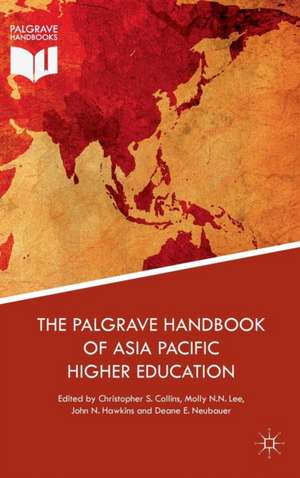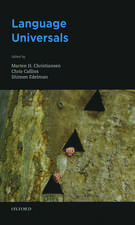The Palgrave Handbook of Asia Pacific Higher Education
Editat de Christopher S. Collins, Molly N.N. Lee, John N. Hawkins, Deane E. Neubaueren Limba Engleză Hardback – 7 oct 2016
Preț: 1613.66 lei
Preț vechi: 1773.25 lei
-9% Nou
Puncte Express: 2420
Preț estimativ în valută:
308.77€ • 321.75$ • 255.66£
308.77€ • 321.75$ • 255.66£
Carte tipărită la comandă
Livrare economică 31 martie-05 aprilie
Preluare comenzi: 021 569.72.76
Specificații
ISBN-13: 9781137487384
ISBN-10: 1137487380
Pagini: 628
Ilustrații: XXX, 691 p. 20 illus., 16 illus. in color.
Dimensiuni: 155 x 235 x 38 mm
Greutate: 1.18 kg
Ediția:1st ed. 2016
Editura: Palgrave Macmillan US
Colecția Palgrave Macmillan
Locul publicării:New York, United States
ISBN-10: 1137487380
Pagini: 628
Ilustrații: XXX, 691 p. 20 illus., 16 illus. in color.
Dimensiuni: 155 x 235 x 38 mm
Greutate: 1.18 kg
Ediția:1st ed. 2016
Editura: Palgrave Macmillan US
Colecția Palgrave Macmillan
Locul publicării:New York, United States
Cuprins
Part A: Asian Higher Education in the Era of Contemporary Globalization.- Introduction—Collins, Hawkins, Lee, Neubauer.- Chapter 1: John N. Hawkins, “Education in the Asia/Pacific Region: Historical Context”.- Chapter 2: Sheng Ju Chan “A Journey Back to the Center: Asian Higher Education in Global Context”.- Chapter 3: Anthony Welch, “Asian Higher Education: Achievements, Challenges, Prospects”.- Chapter 4: Deane E. Neubauer and John N. Hawkins, “Prospects for Higher Education in the Midst of Globalization”.- Chapter 5: Christopher Ziguras, “Globalization and the Transformation of Asian Higher Education”.- Chapter 6: Christopher Collins, “Public Good in Asian Higher Education”.- Chapter 7: Molly N. N. Lee, “Strategies for Higher Education in the Contemporary Era: Public-Private Partnerships and Regional Cooperation”.- Part B: The Forces of Regionality in Asian higher education—Introduction Christopher S. Collins, John N. Hawkins, Molly N.N. Lee, Deane E. Neubauer.- Chapter 8: Jane Knight, “Regionalization of Higher Education in Asia Functional, Organization, and Political Approaches (FOPA)”.- Chapter 9: Molly N. N. Lee, “Regional Trends in Asian Higher Education”.- Chapter 10: Kazuo Kuroda, “Regionalization of higher education in Asia”.- Chapter 11: Michael Lanford and William G. Tierney “The International Branch Campus: Cloistered Community or Agent of Social Change?”.- Chapter 12: Hu Die Wen Wen, “China’s approach towards HE regional cooperation with ASEAN”.- Chapter 13: Miki Sugimura, “Transformation of Higher Education Systems in the Dynamics of Contemporary Globalization: The Case of Japan.”.- Chapter 14: Edilberto C. de Jesus, “Cross Currents in Asian Higher Education”.- Chapter 15: Jinghuan Shi, Lyeong Jo, and Jiayi Li, “Prospects for Higher Education in the Asian Region with Specific Reference to China.”.- Chapter 16: Rui Yang, “Cultural Challenges Facing East Asian Higher Education: A Preliminary Assessment”.- Chapter 17: Akiyoshi Yonezawa “Can East Asian Universities Break the Spell of Hierarchy? The Challenge of Seeking an Inherent Identity”.- Chapter 18: Molly N.N. Lee, “Reforms of University Governance and Management in Asia: Effects on Campus Culture”.- Chapter 19: Christopher S. Collins, Athena Castro, and Tasha Kawamata Ryan, “The Driving Forces of Higher Education: Westernization, Confucianism, Economization, and Globalization” Part C: Access, equity, capacity and quality in the overall context of the massification of Asia Higher Education—Introduction Christopher S. Collins, John N. Hawkins, Molly N.N. Lee, Deane E. Neubauer.- Chapter 20: Prompilai Buasuwan and Wanwisa Suebnusorn, “Higher Education Inequality in East and South-East Asia”.- Chapter 21: Yuchen Yang, “Higher Education in China: Massification, Accessibility, and Quality Issues”.- Chapter 22: Peter D. Hershock, “Equity and Higher Education in the Asia Pacific”.- Chapter 23: W. James Jacob and Weiyang Xiong, “Higher Education Capacity for What? Balancing Issues of Equity, Efficiency, Choice, and Excellence”.- Chapter 24: Yuto Kitamura: “Higher Education in Cambodia: Challenges to Promote Greater Access and Higher Quality.”.- Chapter 25: Angela Hou, “Quality Assurance in Asian Higher Education: Challenges and Prospects”.- Chapter 26: Ralph Wolff, Current Issues With Accreditation in the United States.- Chapter 27: Reiko Yamada, “Impact of Globalization on Japanese Higher Education Policy: Examining Government Control and Quality Assurance”.- Chapter 28: Ka Ho Mok and Sheng-Ju Chan, “After Massification and Response to Internationalization: Quality Assurance of Higher Education in Taiwan and Hong Kong”.- Chapter 29: Sheng Yao Cheng and Ming-li Yao “The Paradigm Shift on Quality Assurance of Higher Education in Taiwan”.- Part D: Country Cases—Introduction: Christopher S. Collins, John N. Hawkins, Molly N.N. Lee, Deane E. Neubauer.- Chapter 30 : Ma Wanhua, “Massification of Chinese Higher Education: Policies and Practices”.- Chapter 31: Morshidi Siratand Chang Da Wan “Higher Education in Malaysia”.- Chapter 32: Serafin L. Ngohayon and Julian B. Nangpuhan II, “Pushing For Globalized Higher Education in the Philippines: Advances and Challenges”.- Chapter 33: Yuan Xun, “Situating Higher Education in China: From Universal History to the Research Paradigm”.- Chapter 34: Ekaphon Lauhathiansind and Nongnuch Chunbandhit, “Thai Higher Education”.- Chapter 35: Shyam Menon, “Higher Education in India: Against the Backdrop of the Evolving Political Economy”.- Chapter 36: Jason Tan, “Singapore: A Small Nation With Big Dreams of Being a Global Schoolhouse”.- Chapter 37: Chiara Logli, “Higher Education in Indonesia: Contemporary Challenges in Governance Access and Quality”.- Chapter 38: Sarah French and Richard James, “Australian Higher Education”.- Chapter 39: Francis L. Collins and Nick Lewis, “New Zealand Universities: The Prospects and Pitfalls of Globalizing Higher Education”.- Chapter 40: Peter Tan Keo and Alexander Jun, “Higher EducationalInstitutions and ASEAN: Current Trends and Implications for Innovation and Change”.- Chapter 41: Menho Yeom, “The Rapid Growth of Higher Education in South Korea: Achievements, Dilemmas, and Resolutions”.- Chapter 42 : Phuong-Lan Bui “Vietnam: The Demand for Change and the Direction Taken”.- Chapter 43: Lyudmila Kovalea and Jack T. Lee, “Higher Education in Kazakhstan”.
Notă biografică
Christopher S. Collins is Assistant Professor of Higher Education at Azusa Pacific University, USA. His research interests include the role of higher education related to poverty reduction, knowledge extension, public good, and social rates of return.
Molly N.N. Lee is an education consultant from Malaysia. She is the former Programme Specialist in Higher Education at The United Nations Educational, Scientific and Cultural Organization in Bangkok. Prior to joining UNESCO, she was Professor of Education at the Universiti Sains Malaysia, Malaysia.
John N. Hawkins is Co-Director of the East West Center’s Asian Pacific Higher Education Partnership and Professor Emeritus of Social Sciences and Comparative Education in the Graduate School of Education at the University of California, Los Angeles, USA. He has served as president of the Comparative and International Education Society, and editor of the Comparative Education Review.
Deane E. Neubauer is Emeritus Professor of Political Science at the University of Hawaii, Manoa, USA, and Co-Director of the Asia Pacific Higher Education Research Partnership (APHERP), a twenty-four member research group consisting of higher education institutions and other related entities interested in studying the dynamics of higher education in the Asia Pacific region.
Textul de pe ultima copertă
This volume seeks to identify and explore the forces affecting higher education in the Asia Pacific region today. It includes a set of conceptually-rich organizing chapters followed by detailed country-specific studies that detail both the underlying dynamics of these forces and the manner in which they have affected specific countries. In this way, the chapters touch on the complex demographics of the region, how continued and continuous economic development impinges on higher education, and how neoliberalism has affected higher education across many dimensions. The volume also addresses the complex issues associated with cross border education and the daunting challenges of both national and cross-national quality assurance.
Caracteristici
Discusses challenges facing education in general and higher education in the Asia Pacific region in particular Chapters detail the process of the massification of higher education Brings together more than two dozen top international scholars in the field of higher education in the Asia Pacific region





